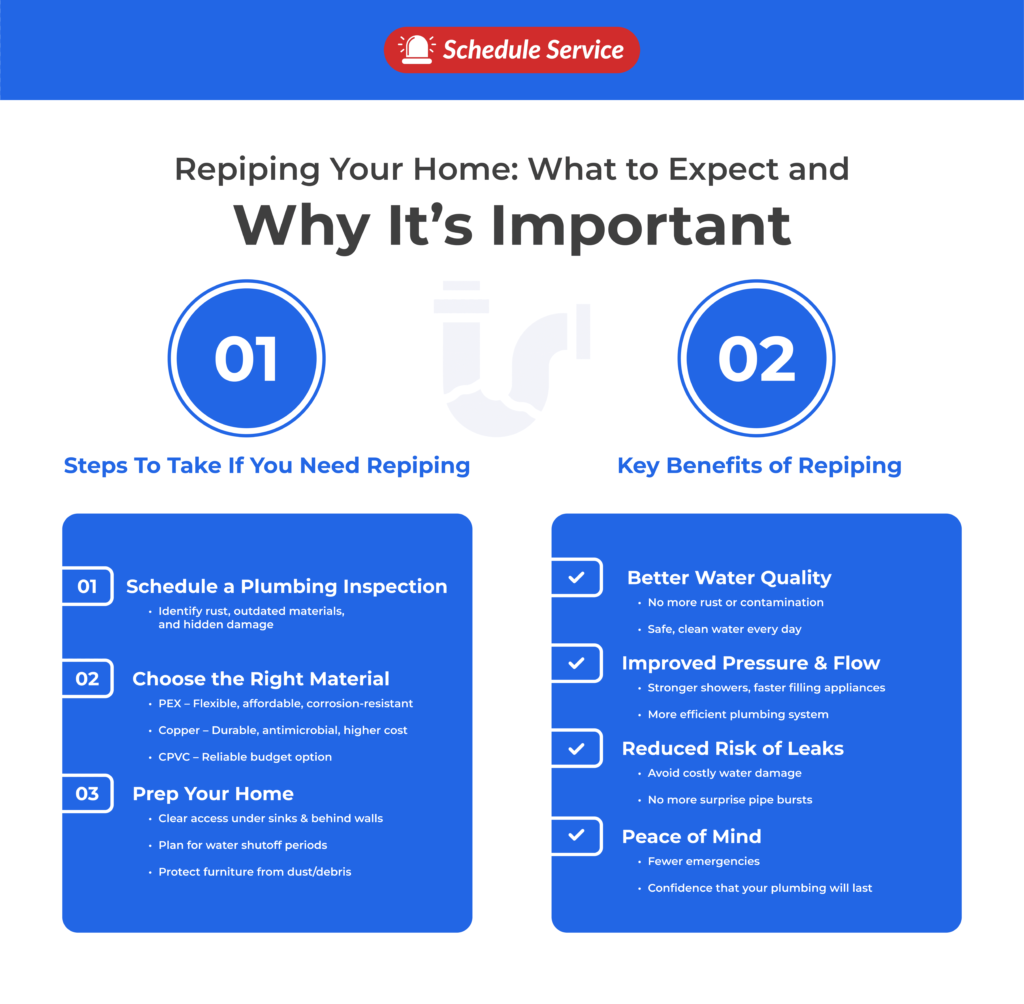5 Signs Your Home Needs Repiping
Rusty water, low water pressure, or frequent leaks in your home could be signs that your plumbing system is reaching the end of its lifespan. This usually happens when pipes naturally corrode, clog, or weaken, which leads to costly plumbing issues. At this point, you can either continue repairing these problems or choose to repipe your entire home.
In this guide, we’ll explain what repiping is, the early signs you need repiping, and why addressing the issue early can save you time, money, and future problems.
What is Repiping?

Repiping is a process where you replace all the older water pipes in your home with new ones. This involves changing the entire system because over time, the pipes in your home can wear down or start leaking. When you see these problems happening more frequently, it means you have to replace the old system.
Repiping your home is necessary because these plumbing systems are built to last for decades, not forever. Also, these pipes are made up of different materials, such as copper or galvanized steel, and each of them has a certain lifespan. Thus, when they hit their lifespan, it means you have to install new pipes to avoid water damage.
Here are some common plumbing pipe replacement signs:
1. Discolored or Rusty Water
If you notice rusty or brown colored water coming from your taps, then it is an indication that your pipes are corroded. This occurs more frequently when your pipes are of galvanized steel or iron. With time, the inner side of such pipes may break down. Once this occurs, rust particles pass into your water and make it yellow, orange, or brown.
Rust can spoil both the taste and odor of your water. It can contaminate water, which can affect appliances such as washing machines and dishwashers by clogging filters. To determine whether your water is rusty, fill a transparent glass with water from a few different sources. If the coloration is evident in all taps, the problem lies in your pipes.
2. Frequent Plumbing Leaks
If you are seeing leaks more frequently in different areas of your home, it means there is a problem with your plumbing system. Pipes naturally wear down over time and begin to weaken from the inside out. When this happens, small shifts in water pressure or temperature can cause the thin pipe walls to crack or develop pinholes, resulting in water leakage.
If you are noticing these leaks, don’t ignore them because they can lead to costly water damage and promote mold growth. You can either spend more time and money on these frequent repairs or go for a long-term solution and repipe your entire home to fix the leakage.
3. Low Water Pressure
Lower water pressure throughout your home means that your pipes are clogged. This happens when minerals in the water start building up inside your pipes. As the buildup gets worse, the space inside the pipes becomes narrower. This reduced space can slow down the water flow, which results in low water pressure.
This low water pressure can be annoying and can affect your everyday tasks. For example, your daily showers, or your washing machine or dishwasher, take a longer time to fill up. To check the water pressure, you can also use a simple pressure gauge. If the reading is consistently low, you may have to repipe to restore proper flow throughout your home.
4. Strange Noises from Pipes
If you are noticing some odd sounds like banging, knocking, or gurgling through your pipes, it means something is not right inside your pipes. The noises can be caused by trapped air, loose fittings, or may be due to internal damage. One other common issue is a water hammer, which is a loud banging noise that happens when water suddenly stops or changes direction inside the pipe.
Sometimes, these noises are occasional, but if you are hearing these noises constantly, do not ignore them. Also, if the noises are getting louder or are happening in several parts of the home, it could mean your plumbing system needs repiping. A professional plumber can help in this regard, as they can evaluate whether it is a small issue or a larger one.
5. Old Plumbing System
If your home is more than 40 to 50 years old and still has its original plumbing, you may have to consider an upgrade, as your piping system is already at the end of its lifespan. For example:
- Galvanized steel usually lasts 20 to 50 years before rust and mineral buildup begin to cause major issues.
- Copper can last longer, up to 70 or 80 years, but it depends on water quality and how well it was installed.
- PEX, one of the newer materials, is durable and corrosion-resistant and has a minimum lifespan of 50 years or more.
When these plumbing systems reach the end of their lifespan, you are going to notice low water pressure, frequent leaks, or water that looks discolored. These are all signs your system is now breaking down from the inside.
Steps to Take if You Need Repiping

If you have observed signs such as discolored water, low pressure, or recurring leaks, it means there is a clear problem with your old piping system. You can fix these issues by repiping the home plumbing system. Here’s what you need to know.
Professional plumbing inspection
Before going directly for repiping, it is important to get insights from a licensed plumber to inspect your system. A professional will examine your pipes for rust, corrosion, leaks, or outdated materials. An experienced plumber will give you an honest assessment and walk you through your options.
They will also assess your water pressure and check for hidden issues that might not be obvious at first. These inspections will help you confirm whether full repiping is needed or if targeted repairs can do the job. In most cases, especially in older homes or properties experiencing consistent plumbing problems, it is better to go for a full replacement.
Choosing the right piping materials for your home
Once you have decided on repiping, the next step is to select the best piping material for your needs and budget. Nowadays, most homeowners choose between PEX, copper, or PVC. Here’s a breakdown of each:
- PEX is one of the most common options for residential homes. It is corrosion-resistant, which makes it ideal for long-term use.
- Copper is known for its durability and longer lifespan, but it costs more compared to other pipes.
PVC is a good choice if you are looking for something more affordable than copper but still reliable.
Preparing your home for repiping work
Before the repiping work starts, it’s important to prepare your home to make the process easier and less messy. Clear the areas where plumbers will work. The plumbing team will usually give you a schedule and let you know which parts of your home will be affected.
You should also be ready for limited water use during the job. In some cases, it may be helpful to stay somewhere else during the busiest part of the work. A good plumbing team will keep you updated and try to make things as smooth as possible.
Benefits of Timely Repiping
Repiping your home may seem like a lot of work, but it delivers real plumbing improvements and also provides long-term benefits. Here is a breakdown of what you can expect.
Enhanced home safety and water quality
One of the most important benefits of repiping is better water quality. Old pipes get corroded and contaminate your water with rust, sediment, or even bacteria into your water. This can affect not just the taste and color of the water, but its overall safety. However, with new piping, you can enjoy clean, fresh water throughout your home.
Improved plumbing performance and efficiency
With new pipes in place, your water pressure becomes more reliable and consistent. You will notice the difference right away with faster filling and better showers. Plus, your plumbing system will operate more efficiently and reduce the chances of recurring clogs, strange noises, or the need for constant maintenance.
Increased property value and peace of mind
For homeowners thinking long-term, repiping can also boost their property’s value. Buyers are more interested in properties that are in good condition and require fewer repairs. Also, repiping provides peace of mind because you won’t have to constantly worry about leaks, water damage, or whether your water is safe to use.
Schedule a Repiping Estimate Today!
Your plumbing system is one of the most important parts of your home, but it won’t last forever. If you have noticed signs like discolored water, low pressure, or recurring leaks, it may be time to consider repiping. Upgrading your pipes not only improves your water quality and pressure but also protects your home from water damage, boosts efficiency, and adds long-term value.
Don’t wait for small plumbing problems to turn into costly emergencies. Contact our team at I Need a Plumber Now for a professional inspection and reliable repiping solutions for your home!
Frequently Asked Questions
How long does repiping take?
Repiping a home typically takes 2 to 5 days. However, it can also take more days, depending on the size of your property and the complexity of the plumbing system.
What materials are best for repiping?
PEX and copper are the most commonly recommended materials for repiping. PEX is flexible, corrosion-resistant, and cost-effective, while copper is durable and long-lasting.
Is repiping worth the investment?
Yes, repiping improves water quality, boosts water pressure, reduces the risk of leaks, and increases your home’s value. It’s a long-term solution that saves money compared to repeated repairs.
Does a homeowner’s insurance cover repiping?
Homeowners’ insurance typically does not cover the cost of repiping. However, it may cover water damage caused by a burst pipe. It is best to review your coverage or speak with your insurance provider for details.





